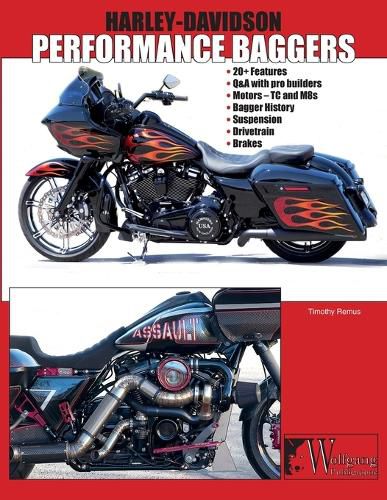Readings Newsletter
Become a Readings Member to make your shopping experience even easier.
Sign in or sign up for free!
You’re not far away from qualifying for FREE standard shipping within Australia
You’ve qualified for FREE standard shipping within Australia
The cart is loading…






This title is printed to order. This book may have been self-published. If so, we cannot guarantee the quality of the content. In the main most books will have gone through the editing process however some may not. We therefore suggest that you be aware of this before ordering this book. If in doubt check either the author or publisher’s details as we are unable to accept any returns unless they are faulty. Please contact us if you have any questions.
The first motorcycle that you can call a Bagger showed up in the show rooms in 1980.That new frame was longer, and the motor and transmission were mounted on rubber mounts. Those first Baggers came with Shovels, followed by Evos, but no one called those Performance Baggers. The Twin Cam motors came next, and they were definitely faster, but the phrase Performance Bagger still didn't come into use until the M8 came on the scene.
This book brings you a detailed look at these new M-8 Baggers, and the Twin Cams that proceeded. The book includes interviews with people like Rick Ward and Bert Baker. Builders who spent a lifetime getting more horsepower and improving the drivetrain. For advice on brakes and suspension, we have information from the staff of Beringer and Ohlins.
In addition to the techs and experts, the bulk of the pages are filled with pictures and the story of true Performance Baggers owned by regular riders - on Road Glide and Street Glide. Each of those stories cover the motors, the drivetrain and the chassis.
Some went all the way with a 143 cubic inch M-8 with a blower, motors well over 200 horsepower. Other owners simply installed bigger jugs, ported heads, a good dyno run and settled for something like 140 or 150 horses. The same goes with the chassis: new shocks and replaced (or upgraded) fork assemblies. For brakes maybe they install new front rotors and retain the factory calipers or replace all the components. What they did or didn't do is a lesson to readers in all the possible modifications.
Written by Timothy Remus with help with experienced builders and experienced owners, H-D Performance Bagger is a high-quality guide for anyone with a late model Bagger or plans to buy that new Bagger.
$9.00 standard shipping within Australia
FREE standard shipping within Australia for orders over $100.00
Express & International shipping calculated at checkout
This title is printed to order. This book may have been self-published. If so, we cannot guarantee the quality of the content. In the main most books will have gone through the editing process however some may not. We therefore suggest that you be aware of this before ordering this book. If in doubt check either the author or publisher’s details as we are unable to accept any returns unless they are faulty. Please contact us if you have any questions.
The first motorcycle that you can call a Bagger showed up in the show rooms in 1980.That new frame was longer, and the motor and transmission were mounted on rubber mounts. Those first Baggers came with Shovels, followed by Evos, but no one called those Performance Baggers. The Twin Cam motors came next, and they were definitely faster, but the phrase Performance Bagger still didn't come into use until the M8 came on the scene.
This book brings you a detailed look at these new M-8 Baggers, and the Twin Cams that proceeded. The book includes interviews with people like Rick Ward and Bert Baker. Builders who spent a lifetime getting more horsepower and improving the drivetrain. For advice on brakes and suspension, we have information from the staff of Beringer and Ohlins.
In addition to the techs and experts, the bulk of the pages are filled with pictures and the story of true Performance Baggers owned by regular riders - on Road Glide and Street Glide. Each of those stories cover the motors, the drivetrain and the chassis.
Some went all the way with a 143 cubic inch M-8 with a blower, motors well over 200 horsepower. Other owners simply installed bigger jugs, ported heads, a good dyno run and settled for something like 140 or 150 horses. The same goes with the chassis: new shocks and replaced (or upgraded) fork assemblies. For brakes maybe they install new front rotors and retain the factory calipers or replace all the components. What they did or didn't do is a lesson to readers in all the possible modifications.
Written by Timothy Remus with help with experienced builders and experienced owners, H-D Performance Bagger is a high-quality guide for anyone with a late model Bagger or plans to buy that new Bagger.